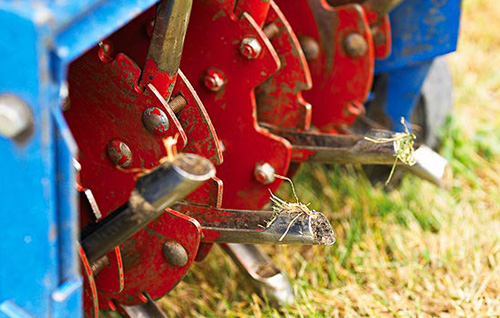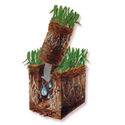
What is Aeration?
Aeration is the process of reducing soil compaction by removing hundreds of small cores of earth (about the size of your finger) and depositing them on top of the lawn. The resulting holes provide the BIG benefits to the lawn.
Over time your soil naturally becomes compacted, leaving the subsoil undesirable for healthy lawn growth. Walking, mowing, and watering compacted particles reduce the air space necessary for root growth. Compaction is the greatest in the upper 1 to 1 ½ inches of soil and needs to be relieved by mechanical aeration. This mechanical process plus 2-3 inch deep, finger size holes into the soil to improve the air, water and nutrient exchange with your roots.
This process combines the benefits of a standard aeration with the added benefit of new seed broadcast over the entire yard. This is a routine maintenance service that will keep a healthy lawn looking great. Aeration reduces soil compaction while pulling up fresh “cores” of soil that are beneficial to the seeding process. Overseeding allows for different varieties of grass to be added to your lawn, increasing species diversity and maximizing the health of the turf. This process makes your lawn more resilient to environmental stress, disease and insect pressure. Seeding guidelines are provided to our customers to ensure the maximum results are achieved with the proper care.
Core aeration will help.
- Stimulate root growth.
- Enhance water intake.
- Reduce compaction.
- Improves oxygen content.
- Enhances thatch control.
- Improves nutrients availability.
Why Aeration?
After years of foot traffic, child’s play, and other activities on your lawn, the soil becomes very hard and compacted. Compacted soils don’t leave much space for roots to grow. I’m sure you can appreciate that it’s next to impossible to have a lush lawn when the grass roots are struggling for room to grow. So, aeration relieves the compaction and makes room for the roots of your lawn to thrive!
However, reducing soil compaction does even more, loose aerated soil will improve the ability of air and water to reach the roots of your lawn. A hard lawn will not easily absorb water, in fact, most of the water will pool on the surface and evaporate or run off. Likewise, air crucial to your lawns’ survival has a very difficult time reaching the grass roots.
Benefits of Aeration

All the holes punched in the lawn have another interesting benefit. You see, Kentucky Bluegrass spreads by growing “rhizomes”. These rhizomes are a special kind of root that grows horizontally just under the soil surface and may grow several inches or more from the mother grass plant. At some distance from the mother plant, the rhizome naturally sprouts a new baby grass plant. When these rhizomes are severed, as aerating does, many new young grass plants sprout up from the ends of the cut rhizomes. What a great way to rejuvenate an old lawn!
By providing a healthier environment for your grass to grow with regular aerating, you will also improve your lawns resistance to diseases.
How often?
I bet you’re asking yourself… how often does this need to be done? Well, it really depends on your lawn. Golf courses aerate the greens at least twice each year! But for most home lawns with average usage, aerating every second year is recommended.



